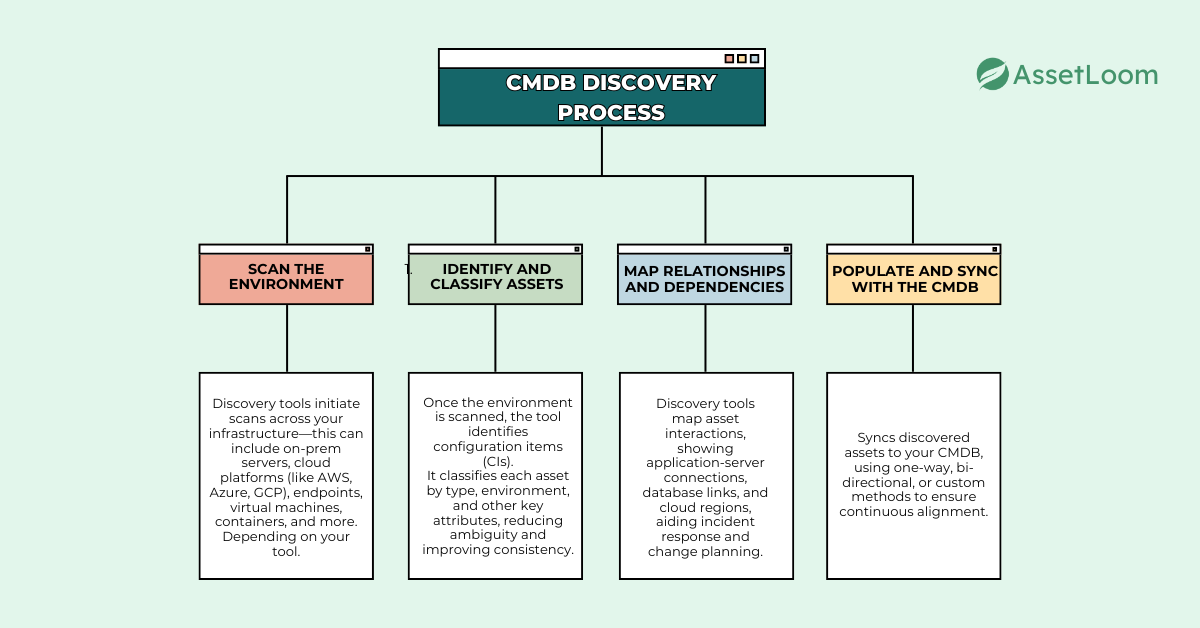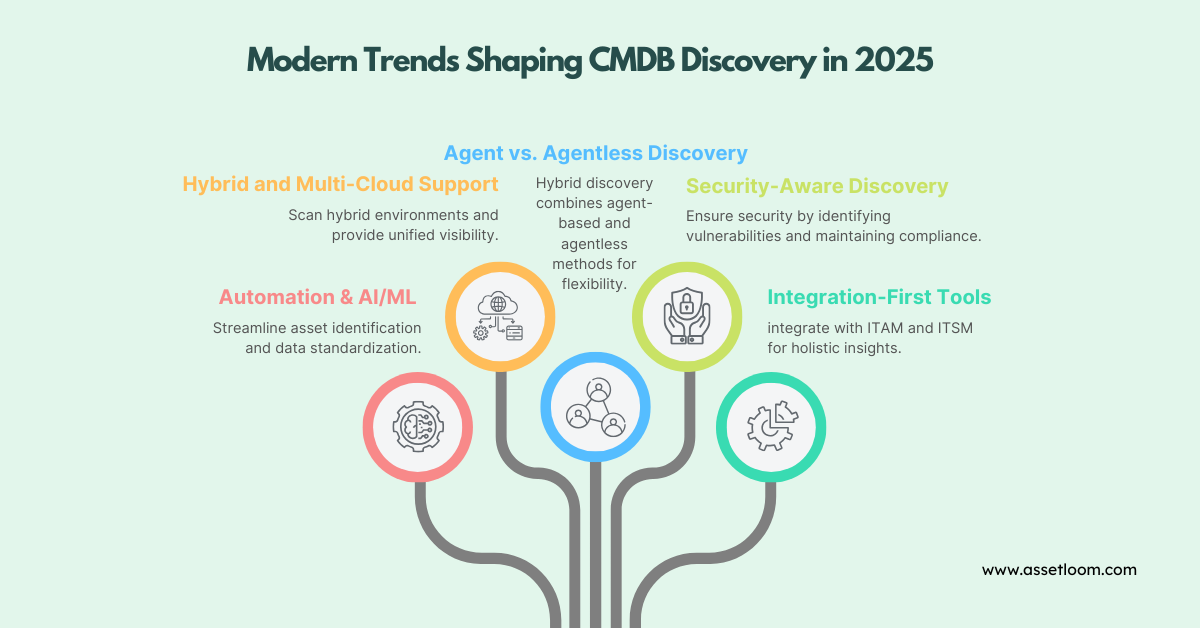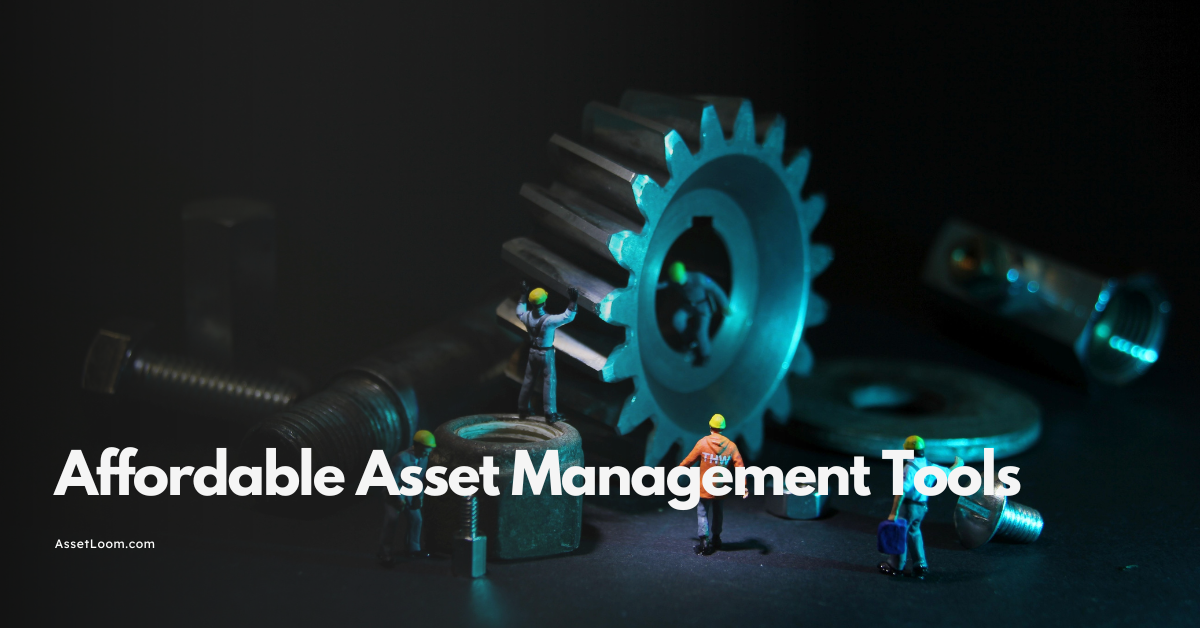CMDB Discovery in 2025: A Complete Overview
Explore the importance of CMDB discovery in 2025, key trends shaping the practice, and why it’s essential for modern ITAM and ITSM success.
CMDB discovery is more critical than ever in 2025—but many IT teams still struggle with outdated data, missing relationships, and manual CMDB updates. The result? Slower incident resolution, audit failures, and poor visibility across today’s complex, hybrid IT environments.
In IT Service Management (ITSM) and IT Asset Management (ITAM), the CMDB is foundational. But when it’s unreliable, everything from service delivery to compliance starts to break down. With hybrid cloud, containers, and remote endpoints in play, manual CMDB maintenance just can’t keep up. That’s where CMDB discovery comes in—automating the identification, cataloging, and updating of assets and dependencies to turn your CMDB into a dynamic, trustworthy source of truth.
In this complete overview, we’ll break down what CMDB discovery actually means in 2025, explore the trends reshaping it, and offer practical advice to help you improve or implement it in your organization. Let’s dive in.
What Is CMDB Discovery?
At its core, CMDB discovery is the process of automatically identifying and collecting data about IT assets and their configurations—then feeding that data into your Configuration Management Database (CMDB).
Think of it as giving your CMDB a constant stream of fresh, accurate intel about what’s really in your environment.
1. Manual vs. Automated Discovery
In the early days, teams relied on manual methods to populate the CMDB—spreadsheets, ticket notes, tribal knowledge. But manual discovery is:
- Time-consuming
- Prone to human error
- Instantly outdated
Automated CMDB discovery flips the script. It continuously scans your environment for changes, reducing the burden on IT teams and ensuring your CMDB reflects reality—not a snapshot from six months ago.
2. How Do Discovery Tools Work?
Modern CMDB discovery tools use a mix of techniques to gather data:
- Agent-based discovery: Lightweight software agents installed on endpoints collect deep system details.
- Agentless discovery: Uses protocols like SSH, WMI, or SNMP to remotely query assets—great for fast, wide-scale scans.
- API-based discovery: Connects with cloud platforms, SaaS tools, and other systems to pull structured data.
- Integrations: Ties into ITAM, ITSM, or monitoring platforms to enrich and verify CMDB entries.
This layered approach gives you a 360-degree view of your IT landscape—hardware, software, virtual assets, cloud resources, dependencies, and more.
3. How CMDB Discovery Fits in the ITSM/ITAM Ecosystem
CMDB discovery is the engine that keeps your ITSM and ITAM processes running smoothly. Accurate, real-time asset data enables:
- Faster incident and problem resolution
- Smarter change management with impact analysis
- Better compliance and audit trails
- More informed capacity planning and forecasting
In short, CMDB discovery ensures that your CMDB isn’t just a dusty database—it’s a living, breathing source of truth that drives better decisions across IT.
How CMDB Discovery Works
So how does CMDB discovery actually work behind the scenes?
While different tools may vary in approach, the core process follows a fairly consistent flow. Think of it as a smart radar system, continuously scanning your digital environment to map out what’s there, how it’s configured, and how it all connects.
Step-by-Step Breakdown of the CMDB Discovery Process

1. Scan the Environment
Discovery tools initiate scans across your infrastructure—this can include on-prem servers, cloud platforms (like AWS, Azure, GCP), endpoints, virtual machines, containers, and more. Depending on your tool, these scans can be:
- Scheduled (e.g., daily or weekly)
- Triggered by events
- Continuous for real-time updates
2. Identify and Classify Assets
Once the environment is scanned, the tool identifies configuration items (CIs) such as:
- Hardware (servers, routers, switches)
- Software (installed apps, services, OS versions)
- Cloud resources (VMs, storage, containers)
- Virtual assets (hypervisors, virtual networks)
It classifies each asset by type, environment, and other key attributes, reducing ambiguity and improving consistency.
3. Map Relationships and Dependencies
This is where discovery tools shine. They don't just list assets—they map how they interact. For example:
- Which application runs on which server?
- What database does it connect to?
- Which cloud region is it deployed in?
These dependency maps help teams understand impact during incidents, plan changes with confidence, and ensure service reliability.
4. Populate and Sync with the CMDB
Once assets and relationships are discovered, the tool pushes this data into your CMDB. The sync can be:
- One-way (push data into CMDB)
- Bi-directional (sync changes across platforms)
- Custom (using rules to validate or enrich data before sync)
This step keeps your CMDB aligned with reality—automatically and continuously.
The Business Case: Why CMDB Discovery Matters More Than Ever in 2025
Let’s be honest—bad CMDB data leads to bad outcomes. If your configuration data is outdated, incomplete, or inaccurate, your IT operations are operating on guesswork. And in 2025, with the complexity of modern IT environments, that’s a risk few organizations can afford.
What Happens Without CMDB Discovery?
Here’s what we hear from teams struggling with CMDB accuracy:
- Service disruptions caused by changes made without understanding asset dependencies
- Compliance gaps that show up during audits due to missing or inconsistent records
- Slow, inefficient change management that increases risk and creates bottlenecks
- Wasted resources from redundant tools, unused licenses, or orphaned infrastructure
These aren’t just technical issues—they affect business continuity, customer experience, and bottom-line costs.
How CMDB Discovery Solves These Challenges
By continuously discovering and updating your asset data, modern CMDB discovery tools help you:
- Keep up with constant change in hybrid and multi-cloud environments
- Automate data collection to reduce manual effort and human error
- Provide real-time visibility into asset health, relationships, and dependencies
- Improve decision-making across ITSM and ITAM processes
In 2025, Accurate Data Is a Competitive Advantage
The organizations thriving in 2025 are the ones who treat their CMDB as a strategic asset—not a static database. Whether you’re delivering reliable services, defending against security threats, or proving compliance in audits, CMDB discovery gives you the visibility and control you need to succeed.
Modern Trends Shaping CMDB Discovery in 2025
As IT environments evolve, so do the technologies and best practices behind CMDB discovery. Here are the top trends you should be aware of as you plan for the future:

1. Automation & AI/ML in Asset Detection and Data Normalization
Modern tools now use automation and machine learning to quickly identify assets, reduce manual errors, and standardize data from multiple sources.
These tools also offer predictive insights, helping IT teams proactively address issues—boosting both efficiency and reliability.
2. Hybrid and Multi-Cloud Support — No Longer Optional
With hybrid and multi-cloud now standard, discovery tools must handle:
- Scanning across on-prem, AWS, Azure, and GCP Supporting complex, distributed environments
- Providing unified visibility into all assets, wherever they live
3. Agent vs. Agentless Discovery — What’s Gaining Ground?
- Agent-based discovery delivers detailed data via installed agents—ideal for deep visibility
- Agentless is faster to deploy and ideal for dynamic or large-scale environments Most organizations now use a hybrid approach, combining both for flexibility and coverage.
4. Security-Aware Discovery — Visibility with Compliance
Modern discovery tools are built with security and compliance in mind. They:
- Identify vulnerabilities during asset scans
- Check configurations against benchmarks
- Help maintain compliance while supporting secure operations
5. Integration-First Tools — Connecting ITAM, ITSM, and Observability
Discovery tools now focus on seamless integration with ITAM, ITSM, and observability platforms, enabling:
- A holistic view of IT assets and operations
- Enriched CMDB data with performance and real-time context
- Better decision-making and workflow automation
Staying abreast of these trends helps ensure that your CMDB discovery approach not only meets today’s challenges but is also future-proof for the evolving landscape of IT management.
Choosing the Right CMDB Discovery Tool
With so many tools available, the key to selecting the right CMDB discovery solution is to focus on core functionality and fit for your environment. Here are the essentials to look for:
- Scalability: Can the tool handle your environment as it grows—from on-prem servers to thousands of cloud assets?
- Cloud-Native Support: Look for tools that natively support AWS, Azure, GCP, containers, and serverless services—critical in today’s hybrid world.
- Dependency Mapping: The best tools don’t just list assets—they map relationships between systems, services, and infrastructure to show how everything connects.
- Real-Time or Continuous Sync: Your CMDB should reflect real-time conditions, not outdated snapshots. Continuous sync ensures accuracy for decision-making.
- Seamless Integrations: Ensure the tool integrates smoothly with your existing ITSM, ITAM, and monitoring platforms to enrich your CMDB and support workflows.
A strong CMDB discovery tool gives you more than data—it delivers the visibility and reliability needed to run IT with confidence.
Best Practices for Effective CMDB Discovery
Getting CMDB discovery right isn’t just about choosing the right tool—it’s about using it wisely. Here are some best practices to ensure your discovery efforts are accurate, efficient, and sustainable:
- Define Clear Goals Up Front: Know what success looks like. Are you aiming for complete cloud visibility? Stronger incident response? Compliance readiness? Set measurable objectives before you begin.
- Start with Critical Services First: Don’t try to discover everything at once. Focus on the most critical systems and services to establish quick wins and reduce risk early on.
- Clean Up Old or Duplicate Data: Before importing new data, clean out outdated, redundant, or inaccurate configuration items (CIs). A clean CMDB is easier to maintain and more trustworthy.
- Schedule Regular Scans: CMDB discovery isn’t a one-time task. Set up automated, recurring scans to keep your CMDB current as your environment evolves.
- Collaborate Across Teams: Discovery is a cross-functional effort. Work closely with ITAM, ITSM, security, and operations teams to ensure the data collected is accurate, relevant, and aligned with business needs.
Final Thoughts
In 2025, CMDB discovery isn’t just a technical task—it’s a strategic necessity. With IT environments growing more complex by the day, keeping your CMDB accurate and current is essential for delivering reliable services, managing risk, and staying compliant.
But success doesn’t come from a one-time scan. It requires:
- Continuous discovery
- Cross-team collaboration
- Smart tools that evolve with your infrastructure
A modern, automated discovery process turns your CMDB into a living source of truth—one that supports faster decision-making, stronger incident response, and better business outcomes.

Related Blogs
Subscribe for Expert Tips and Updates
Receive the latest news from AssetLoom, right in your inbox.


